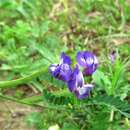Comprehensive Description
provided by North American Flora
Hamosa leptocarpoides (M. E. Jones) Rydb. Bull. Torrey Club 54:326. 1927.
Astragalus Nutlallianus leptocarpoides M. E. Jones, Contr. W. Bot. 8: 22. 1898.
An annual; stem spreading, decumbent or prostrate, 1-1.5 dm. long, sparingly strigose, striate; leaves ascending or spreading, 2-4 cm. long; stipules lance-subulate, 3 mm. long; leaflets 1 1-21, oblong or oblong-cuneate, 3-5 mm. long, retuse, truncate or rounded at the apex, glabrous above, sparingly strigose beneath; peduncles 4-6 cm. long; racemes very short, 1-4-flowered; bracts lance-subulate, 1-2 mm. long; calyx sparingly strigulose, the tube about 2 mm. long, the teeth lance-subulate, 1.5 mm. long; corolla 6-7 mm. long, similar to that of //. Nuttalliana; pod glabrous, linear, 2-3 cm. long, 1.5-2 mm. wide, slightly and evenly arched, 12-20-seeded.
Type locality: Galveston Island, Texas. Distribution: Known only from the type locality.
- bibliographic citation
- Per Axel Rydberg. 1919. (ROSALES); FABACEAE; PSORALEAE. North American flora. vol 24(1). New York Botanical Garden, New York, NY
Comprehensive Description
provided by North American Flora
Hamosa leptocarpa (T. & G.) Rydb.; Small, Fl. SE. U.S 617, 1332. 1903.
Astragalus leplocarpus T. & G. Fl. N. Am. 1: 334. 1838. Tragacanlha leptocarpa Kuntze, Rev. Gen. 946. 1891.
Slender annual; stem at first simple, later branched at the base, 1-3 dm. high, sparingly strigose; leaves ascending, 3-6 cm. long; stipules lance-subulate, 4 mm. long; leaflets 11-19, cuneate-elliptic to cuneate-obovate, retuse at the apex, glabrous above, sparingly strigose on the midrib and margins beneath, 5-10 mm. long; peduncles 5-10 cm. long; racemes 2-4 cm. long, 5-12-flowered; bracts subulate, 2 mm. long; calyx strigose, the tube about 2 mm. long, the teeth subulate, of the same length; corolla purple; banner obovate, retuse, 9-1 1 mm. long; wings 6-8 mm. long, the blade obliquely oblanceolate, somewhat arcuate, rounded at the apex, the auricle reflexed; keel-petals 5-6 mm. long, the blade broadly lunate, the tip slightly porrect, acutish or obtuse; pod linear, glabrous, straight or nearly so, compressed, 2.5-3 cm. long, 2 mm. wide, the lower suture slightly sulcate.
Type locality: Near the Sabine River, Texas. Distribution: Texas and southwestern Arkansas.
- bibliographic citation
- Per Axel Rydberg. 1919. (ROSALES); FABACEAE; PSORALEAE. North American flora. vol 24(1). New York Botanical Garden, New York, NY
Physical Description
provided by USDA PLANTS text
Annual, Herbs, Taproot present, Nodules present, Stems erect or ascending, Stems or branches arching, spreading or decumbent, Stems prostrate, trailing, or mat forming, Stems less than 1 m tall, Stems solid, Stems or young twigs sparsely to densely hairy, Leaves alternate, Leaves petiolate, Stipules conspicuous, Stipules green, triangulate to lanceolate or foliaceous, Stipules membranous or chartaceous, Stipules persistent, Stipules free, Leaves compound, Leaves odd pinnate, Leaves even pinnate, Leaf or leaflet ma rgins entire, Leaflets opposite, Leaflets 10-many, Leaves hairy on one or both surfaces, Inflorescences globose heads, capitate or subcapitate, Inflorescence axillary, Bracts very small, absent or caducous, Flowers zygomorphic, Calyx 5-lobed, Calyx hairy, Petals separate, Corolla papilionaceous, Petals clawed, Petals reddish brown, maroon, Petals blue, lavander to purple, or violet, Petals bicolored or with red, purple or yellow streaks or spots, Banner petal narrow or oblanceolate, Wing petals narrow, oblanceolate to oblong, Wing tips obtuse or rounded, Keel petals auriculate, spurred, or gibbous, Keel tips obtuse or rounded, not beaked, Stamens 9-10, Stamens diadelphous, 9 united, 1 free, Filaments glabrous, Style terete, Style persistent in fruit, Fruit a legume, Fruit stipitate, Fruit freely dehiscent, Fruit elongate, straight, Fruit coriaceous or becoming woody, Fruit exserted from calyx, Fruit beaked, Fruit glabrous or glabrate, Fruit 11-many seeded, Seeds cordiform, m it-shaped, notched at one end, Seed surface smooth, Seeds olive, brown, or black.

